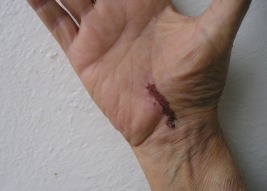Sorry about not posting last week. Every now and then my real job intrudes more than it should. But I’m back on track this week.
For the last few months I have been driven mad with itchiness: my back, neck, shoulders, arms and even thighs. I’m not talking about a small itch, I’m talking industrial-strength itch. The kind that wakes you up at night, and makes you scratch like a crazy person when you should be sitting quietly chatting and drinking coffee with friends. It starts as a little niggle on the thigh or the middle of the back and ends up a roaring itch that won’t stop until you draw blood (well almost).
The first thing I have learned is not to go crazy. Scratching this kind of itch makes it worse, and it quickly becomes a vicious circle: the harder you scratch, the more it itches. I have found that the best approach is to scratch a little, then bear the itch for a minute or so, and it goes away. For a while.
I spoke about it with my nephrologist, who said that it I have too much phosphate in my diet. And the way to control this is to use phosphate binders like caltrate (calcium tablets you buy off-the-shelf) or a heavier duty med, like Fosrenol. He upped my dose for each meal to two caltrate and one large Fosrenol. This is a big dose and should have done the trick. It didn’t. All these binders seemed to have very little effect.
I go to a skin specialist about every four months to make sure I have no skin cancers (a bi-product of the meds I take), and I asked him about my itch. Like everyone else he said that I had too much phosphate, etc. However he did suggest some lotions that can help reduce the itch: one was a prescription ointment called Celestone (betamethasone valerate), a mild steroid cream to minimise the itch, to be applied once at night before bed. Another was an off-the-shelf moisturising lotion called Aveeno which I could apply anytime I had an itch. Finally, he suggested I use QV Intensive Moisturising Cleaner, instead of soap.
These certainly eased the symptoms of the itch, but underneath it was still there.
Then the Unit Manager of my dialysis unit suggested that I talk again to Karen, our dietician. I had spoken with her before, and adjusted my diet to minimise phosphate, but to no avail. This time however, she asked me about all the meds I was on. After discussing each she asked why I was on Somac (Pantoprazole) antacid/anti reflux tablets. I told her it was part of my anti-rejection drugs for my transplant. One of the anti-rejection drugs tended to cause reflux, and Somac minimised its action. However, I had my transplant removed about four months ago.
Then she told me the critical thing (bless her!): phosphate binders only work if you have enough stomach acid in your stomach. No stomach acid, no phosphate binding, no matter how many calcium tablets you take. And Somac was removing/minimising my stomach acid.
Obviously, I stopped the antacids immediately. Nothing much happened for the first few days, but slowly, over the next two weeks, the itch has started to back off. It has not gone completely. I think it is taking time for my stomach acid to return to normal levels and for the phosphate binders to become fully functional. But I no longer need the night lotion, and I’m using the moisturising lotion less and less.
But I think I am over this hurdle.
So, another hard lesson re-learned: don’t assume. Don’t assume that your doctor knows everything; don’t assume that because your meds were right six months ago, they are right for now.
Like liberty, the price of ongoing health is constant vigilance.

 Professional dialysis recruitment
Professional dialysis recruitment

